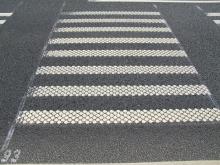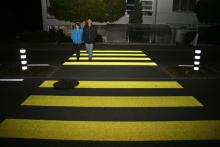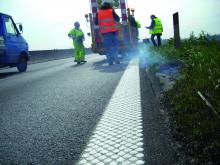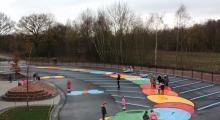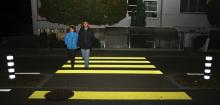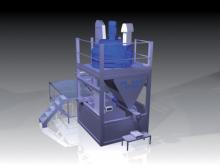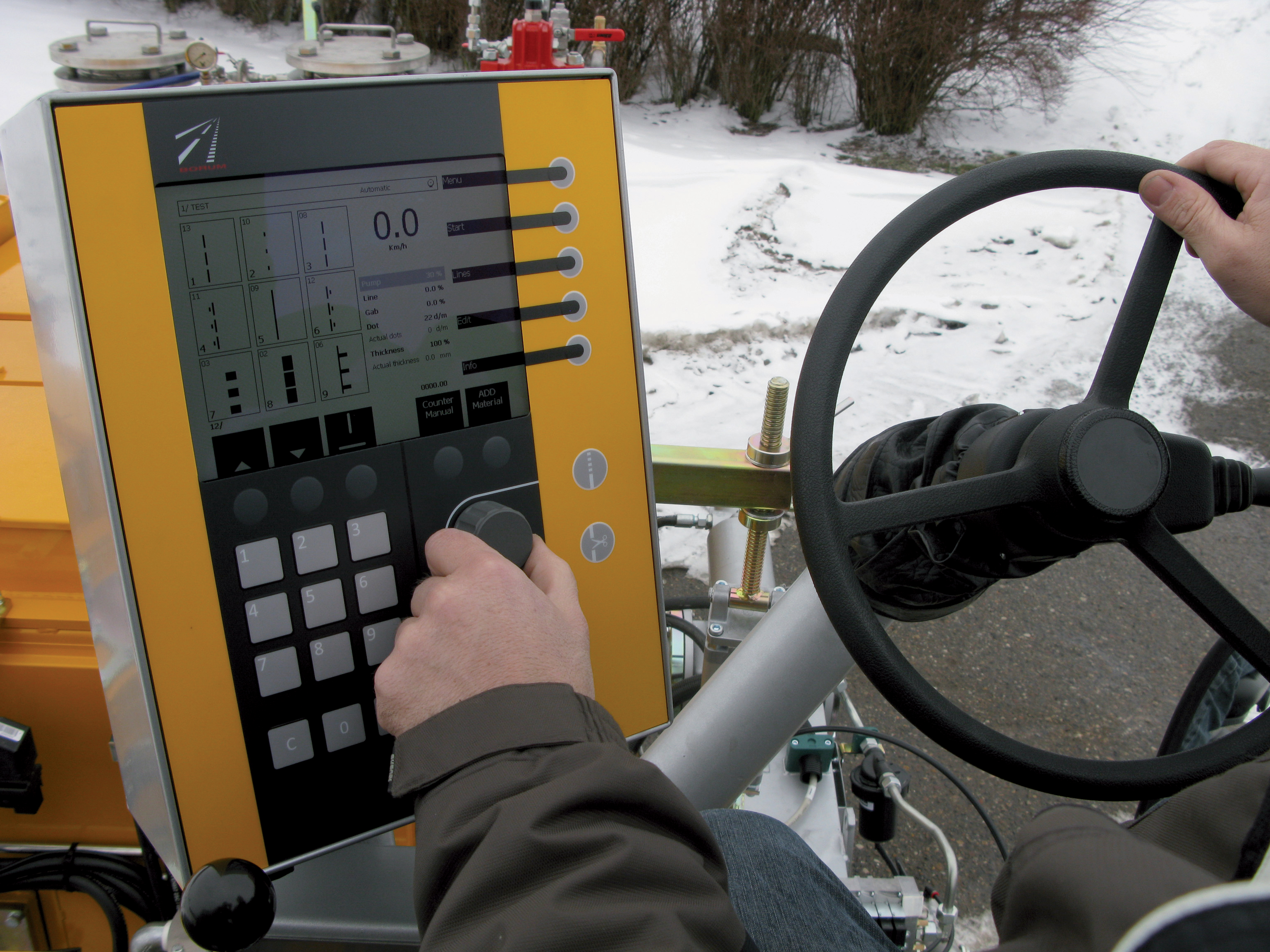
Equipment, materials and testing combine to offer motorists better road markings as Patrick Smith reports
Drivers realise that clear road markings, particularly in darkness and during the wet, are life-savers, offering guidance and direction.Manufacturers of marking materials, in-road studs, and testing and laying equipment have spent years perfecting solutions to make such markings easier to place; easier to see through the use of a variety of materials, and longer lasting. Sophisticated testing equipment is also being introduced to the industry to help make sure these solutions are achieved.
The recent
Borum's LineMaster computer and software system helps operators control all road marking tasks, from line application and pre-marking to reporting and invoicing.
Ole Munch, Borum's managing director, said: "We have recently upgraded all our machines and with the new LineMaster system our product range is now among the most advanced and user-friendly on the market.
"In the road marking industry, new applications tend to mean new add-ons to existing machinery. But with the LineMaster, all the applications are brought together in one system, and add-ons do not take up extra space." Johnny Jørgensen, project manager at Borum, said: "What is great about the LineMaster is that it is scalable. New functions, extra software and upgrades can be installed easily using the USB memory stick. And the intuitive interface makes it so easy to use." Jørgensen and his team have been working on the project for a number of years.
"A good road marker has to drive in a straight line on all kinds of terrain, apply the lines, and keep control of all the different processes simultaneously. With the LineMaster, the high resolution interactive screen gives a great overview of all the important processes, and makes it much easier to operate." Reporting is also said to be easier with information at hand, including the line type and length and the total marked area. Information such as the amount of material used, the air and road surface temperature and the humidity, can be saved on the USB.
The LineMaster will be installed in all new Borum machines.
German road marking machine manufacturer
Hofmann says that the core piece is a specially developed feed pump for highly-viscous plastics with features that are especially important for the road marking area.
Mobile measurements
Meanwhile, Danish company"As these instruments are easy to use for making a limited number measurements they are not optimal for monitoring long distances like motorways. The road also has to be partly closed during measurements," says DELTA.
The company points out that as traffic increases, there is a growing demand for mobile measurement methods, which offer more safety for staff and drivers, particularly in traffic speed.
DELTA says that some existing mobile retrometers on the market have limitations in accuracy.
"For this reason mobile retrometers have until now only been used for screening purposes and hand-held instruments are still needed for precise measurements if low values are screened, and for contractual disputes.
"The limited accuracy of existing mobile retrometers are mainly caused by vehicle movements such as changes, wind and car load (for example fuel consumption) relative to the road surface. These movements change the measurements geometry and cause inaccurate readings." DELTA, which introduced the collimated optics technology in hand-held retrometers more than 30 years ago thus eliminating geometry errors resulting in high accuracy, is now introducing a new mobile retrometer, which is based on a new optical technology that has the same properties as used in its series of hand-held LTL retrometers.
"The objective for the development has been to make a mobile retrometer that should be as easy to use and as accurate as a hand-held retrometer. In addition to this the new mobile retrometer, the LTL-M, will measure line width and other geometry properties and also be able to monitor defect or missing RPMs." Several laboratory and field tests performed by the Swedish Road Research Institute (VTI), comparing the LTL-M, an existing mobile retrometer and using a hand-held instrument as a reference, have shown that the LTL-M measures with accuracy similar to hand-held retrometers, says DELTA.
"The conclusion from the laboratory and the field measurements is that the LTL-M has accuracy comparable with hand-held instruments, and further technical details can be obtained in the VTI report 675A: Evaluations of LTL-M (downloadable form www.roadsensors.com)." Swiss manufacturer
"Our new ZRM 6014 is setting the trend for the future," claims owner and managing director Peter Zehntner.
The main focus with the new unit has been put on speeding up the process of measuring road markings: RL (night visibility) and Qd (day visibility) are measured in less than 2.5 seconds and single measurements of RL or Qd take only one second each. Temperature and air humidity are recorded simultaneously.
The unit's optional built-in camera allows users to get a picture of the marking from the point of view of the measuring instrument (exactly in the measuring geometry), and all data can be transferred to a PC or memory stick either via the standard USB interface or via an optional
On the road At
The suit, made of special sheeting often used in safety clothes and traffic signs, incorporates very small glass beads that can also be used in road markings to improve their visibility.
The sales manager with
He decided the reflective suit would be
one way to promote the benefits of the company's beads.
"I had the idea that this would be a fun way to promote a serious subject at our stand: that of road markings," he said.
One example is
"The excellent retroreflectivity, comparable to that of high index beads, and the good resistance to traffic impact known from our low index beads make SOLIDPLUS a choice where driver and pedestrian safety is a particular issue,", he said.
The class A beads complying with European standard EN 1423 also perform particularly well in coloured road marking materials, for example orange or yellow stripings for special purposes.
When combined with Swarco's liquid high quality marking materials, the titanium-stabilised beads will extend the durability of reflective road markings far beyond the usual performance life.
Another Swarco product, plus9beads are reflectors directly produced from the glass melt and featuring "high purity and outstanding brilliance." With a refractive index of >1.9, plus9beads can be used for both horizontal and vertical applications.
"For vertical usage in highly reflective sheetings and textiles, paints and inks we mainly deliver beads with sizes inferior to 100?m. For horizontal marking systems which require particular visibility we offer high index beads sized up to 1mm in diameter," explains Jesacher.
The plus9spots dRAIN is another milestone for the Amstetten-based engineers. It is the combination of Swarco's top products plus9spots and Megalux-Beads, and is said to guarantee the "ultimate retroreflection boost on wet roads at night." The drop-on material can be used in two-component sprayplastic systems, two-component cold plastic, and thermoplastic as well as in solvent-based or waterborne paints.
According to
The company says that Type II thermoplastic markings with their textured surface solve this problem, allowing ground water to drain away from the tiny domes that stud the markings' surface. However, they usually require a large machine to apply them, and this is not always cost effective if only a small section of markings needs to be repaired.
"Thermoplastic markings can be worn away where motorists repeatedly take an identical line, such as an exit ramp from a motorway," explains marketing and area manager Christian Schou Jensen of Danish exhibitors Geveko.
Meanwhile,
The company says that it has found a way of hardening road markings in a fraction of the normal time.
"Because our new resin hardens so quickly, in many cases there will be no need to block the road while the markings are being applied, which will also help increase economic efficiency," said Degaroute.
Waterblasting tests recycling system
A novel development from Waterblasting will boost productivity when removing painted lines from road surfaces, particularly in hot countries, at remote locations or on long highway jobs.
A water recycling system with filters is mounted on-board and allows the re-use of water within the machine several times.
"It is a major advance in our industry," said David Dorsett, in charge of international marketing for the company.
One of the three machines being tested with this equipment was able to operate for 66 hours on a single tank of water. As the line removal machines can use from 20-45litres/min of water, this recycling technology allows higher productivity, particularly when working in hot climates in Australia, Africa, Asia or parts of the US. Dorsett said: "We can't just use water out of a ditch." The system is still in development but Waterblasting has three trucks being tested in the field in Hawaii, Utah and Nevada with a fourth being sent to a contractor in Michigan. According to Dorsett, operators like the system as it means they can carry on working on site for much longer, without having to leave to refill the water tanks. This option can also reduce transport costs as it means there is no need to bring water bowsers to a working machine to refill its tank, not to mention cutting water costs in countries where this is a scarce source. For jobs in rural areas or on long highway sections where time restrictions may be in place due to lane rentals, the package offers particular benefits.
Dorsett explained, "We've been working on this for three years. It has on on-board filtration system." The filtration package is only available on the company's larger machines, the SH4000 and SH8000, and as Dorset explained: "It's a very large tank." For users the filtration offers further benefits too and the test machines have shown that this package extends consumables life considerably by removing calcium from the water and making it softer.

